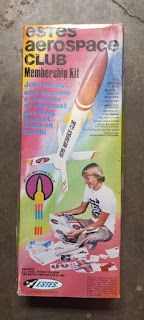Here's both sides of the the purple stripes joining up at the top and bottom of the fin.
In the picture on the right you can see the overlap and two layers of the translucent stripe decal. The ends should have a slight overlap. It's really not that noticeable.
I don't use an overall clear coat on my models.
I do use some Future clear acrylic on the ends of decals like the overlapping purple stripes.
Dip a Q-tip into Future and wipe off the excess on a paper towel.
Roll the clear over the decal ends. Lightly wipe off some of the excess Future.
A small amount of Future will seep under the decal edges and seal the ends.
The vertical EAC decals go on two opposite fins.
Notice the side edges of the decal are curling up after initially placing them.
Roll out the water under the decal with a Q-tip. Keep pressure on the decal and the curling edges will eventually stay down. This is typical of home print decals.
The upper launch lug is in the way of the horizontal tube wrap decal.
Set down the edge, tucked into the lug glue fillet.
Roll around the decal. Tuck in the other end.
Use a razor blade to cut the overlap.


















































